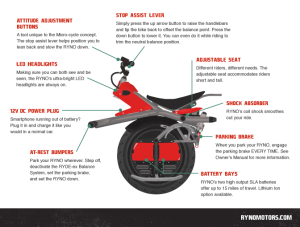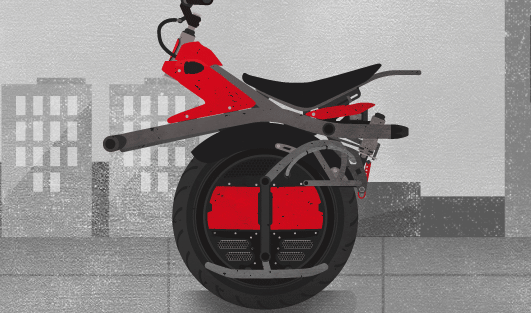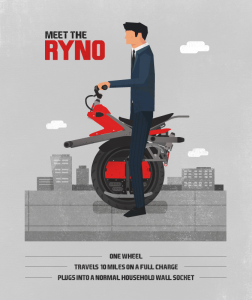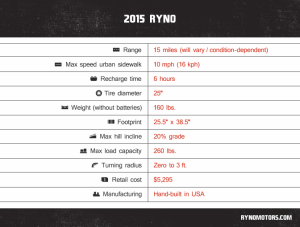With its zero-emissions operation, clever removable battery packs, and jaw-dropping, futuristic, anime-inspired styling, the RYNO concept merges the green movement with a total sense of coolness in a way the Toyota Prius or Divvy rental bike simply doesn’t. Whenever a RYNO is around, people gawk – made clear when my interview was interrupted with the far-off shout: “Hey, RYNO guy!”
As Chris Hoffman politely waved off fans and well-wishers in an attempt to focus on our conversation, it occurred to me that “CEO of RYNO Motors” may not be an appropriate title for this personable, Portland-based engineer. He delivers forward-looking TED Talks and hopes through his company to lead nothing less than a revolution in urban transportation.
A better title? Maybe “Chief Executive Rock Star.”
“Yeah, rock star,” laughs Chris, as I tell him this. “I definitely feel like a rock star, sometimes,” he says while riding his invention from a photo shoot location back to his office at RYNO Motors. “It’s hard not to get attention on one of these.”
“One of these,” of course, is a RYNO, a self-balancing, battery-powered, single-wheeled vehicle the company describes as a microbike. Chris believes the RYNO can deliver on the promises of urban transformations and personal mobility made more than a decade ago by vehicles like the Segway.
“I wouldn’t call it a failure,” Hoffman says in reference to Segway’s inability to transform cities and companies to the degree its inventors originally hoped. “The Segway is a great product and it has its place,” he continues. “It’s just that it’s too big to use in offices and buildings. It takes up a lot of floor space, too, and it puts its riders head and shoulders above everyone else. Like, right now, I’m in an elevator with two or three other people.”
“Wait, you’re in an elevator? Right now?” I ask, cutting him off.
“Yeah,” he says, as the elevator pings. “I ride (my Ryno) everywhere.”
I’m dumbfounded.
“That’s why the RYNO works,” he says. “I don’t take up much more room than I normally would just standing here. I’m standing flat on my feet, with the bike between my legs, and I’m at the same eye level as the other people in the elevator, not towering above them. That’s the key.”
As Hoffman points out, the RYNO’s small footprint and low seat height allow its rider to occupy about the same space as any other pedestrian. That’s a huge advantage, and one that doesn’t apply to previous stand-up electric vehicles like the Segway or the T3 Patroller, used mostly by security firms and law enforcement. The RYNO also takes up less space than the vehicles that may be the RYNO’s real competition: bicycles.
That’s right. Despite the RYNO’s battery packs and its computer-controlled ability to stand on its own, the RYNO isn’t really meant to stay on the sidewalk with the slow-moving walking crowd. Thanks to a governed top speed of 10 MPH and a 10-plus mile range, the RYNO is very much at home in urban bicycle lanes. (The legal speed limit for a motorized transportation device is 10 MPH, so the bike is electronically limited to that. Without such regulation in place, Hoffman claims the RYNO could exceed 25 MPH.) In fact, the RYNO’s powerful electric motors can deliver 100 percent of their torque to the microbike’s single tire instantly from 0 RPM, a trick even the strongest cyclists can’t match. That, and, let’s be honest: Bicycles don’t always easily fit in elevators.
Hoffman hopes advantages like those mentioned above will help drive RYNO sales once the first batch of 300 hits dealers this fall. And all the positive press RYNO Motors has been getting in recent months should bolster those sales efforts. I asked Chris how it felt to be “the brains” behind an overnight success. “It doesn’t feel like an overnight success,” he says. “It’s more like a long journey over the last four years to make this a reality, and we’ve spent a lot of money along the way. Even now that we’re starting to ship bikes, we still have to support the dealers, train them, and do it all in a way that will scale when – ” Hoffman catches himself. “If we need it to scale. If this really takes off.”
 If four years seems like a long time to go from concept to production for a vehicle that is essentially a motorized unicycle, that’s because it is. All the hardware of the RYNO microbike – from the frame to the lighting to the in-wheel motors and battery trays – was designed, tested, redesigned, proven, and tooled up for production more than a year ago. The real challenge for Hoffman and his crew was to get the experience of riding a RYNO to match the expectations of the rider.
If four years seems like a long time to go from concept to production for a vehicle that is essentially a motorized unicycle, that’s because it is. All the hardware of the RYNO microbike – from the frame to the lighting to the in-wheel motors and battery trays – was designed, tested, redesigned, proven, and tooled up for production more than a year ago. The real challenge for Hoffman and his crew was to get the experience of riding a RYNO to match the expectations of the rider.
“People look at the RYNO and expect it to behave like a bike,” Hoffman says. “Our customers expect it to lean into turns when they’re going fast, but unicycles don’t lean. If you’ve ever seen someone ride a unicycle, they come to a stop and twist their bodies, which causes the wheel to pivot on a vertical axis.”
To its credit, RYNO is gearing up to deliver an incredibly agile product that combines the best characteristics of a unicycle, bicycle, and motorcycle. The production version of the microbike leans into corners like a bike before slowing to walking speed and joining the foot traffic on sidewalk. At that speed, the RYNO’s rider can roll right through the doors of an office building and into an elevator before spinning around, pressing the floor button, and effortlessly backing up like any other person on foot.
That kind of agility, from a software point of view, is hard to come by. “That’s what took the most time,” Hoffman says. Sounding like the smartest guy in the room, he explains there was gyro-stabilization to consider, a three-axis gyro with accelerometers, an accelerometer sensor that knows where the center of the earth is, and a gyroscopic sensor that is highly reactive to sensing tilt angles. There’s also a set of motors to drive the wheel back and forth under the center of gravity. The motors have to react with enough force to prevent the tilt angle from coming back to zero. In other words, there’s a whole lot more science and math involved than the average person may realize.
There’s a lot of work necessary to get the RYNO to drive the wheel faster as it goes around a turn, for example. Then there’s a complex ecosystem of hardware and software coming together to make it feel like a bike when you want it to be a bike, and feel like…well, whatever you’d call a machine that takes the need to walk out of walking. If Hoffman has his way, you’d probably end up calling it a RYNO.
RYNO FAQs
Where can you ride a RYNO? In most states, the RYNO is legal to ride anywhere a pedestrian can walk or ride a bike. If you want to move more quickly than foot traffic safely allows, the company recommends moving over into the bike lane where possible.
What if someone complains about where you ride the RYNO? The RYNO is regulated by the Consumer Product Safety Commission (CPSC) rather than the National Highway Traffic and Safety Administration (NHTSA) and is, therefore, subject to the same set of rules as other personal mobility products like scooters or electric wheelchairs.
How much will the RYNO sell for? The first 300 RYNOs should be on their way to dealers by the end of the month. They carry an MSRP of $5,295, making them comparable to vehicles like Vespa scooters or high-end road bikes. A utility rack, available lithium-ion batteries, and a helmet (recommended) are optional extras.
Is the RYNO a “green” vehicle? While the RYNO is a fully electric vehicle that creates no emissions of its own, it does draw power from the electrical grid (which means coal or gas power in much of the U.S.) when it recharges. On average, however, a typical EV produces less than eight percent of the greenhouse gas emissions produced by a typical automobile per mile.
How long will the RYNO’s battery last? The RYNO’s batteries can be charged and re-charged hundreds of times before any noticeable drop in performance occurs, and can be quickly swapped out without special tools, allowing RYNO owners to keep one set of batteries at home and another set at the office, for example. The optional lithium-ion batteries can be fully spent and re-charged well over 1,000 times.
Can you insure the RYNO? Many insurance companies offer insurance for personal mobility devices like electric wheelchairs and scooters. As such, local insurance agents should be able to offer RYNO owners an insurance solution that works for them.
Where can you buy a RYNO? As of this writing, the entire 300-unit production run of RYNOs is already sold out. The company hopes positive customer reviews and dealer experiences will allow them to sign more dealers in crucial markets including New York, Chicago, LA, and (of course) Portland. Look for RYNOs to start popping up in high-end bicycle shops and power-sports dealers in spring of 2015.
Note: Chris Hoffman and I spoke by phone and he talks fast. Some of these quotes are paraphrased from memory.
[divider]
Article written by Jo Borras for Fix.com, 12/5/2014




